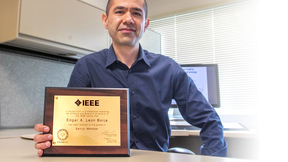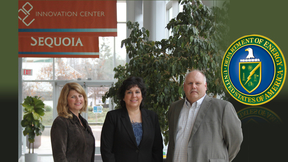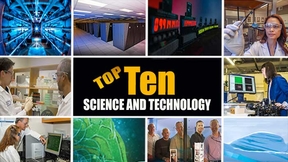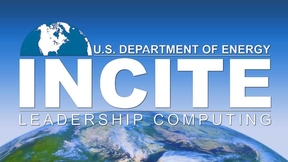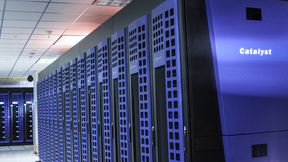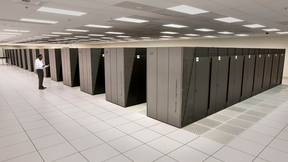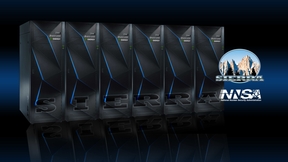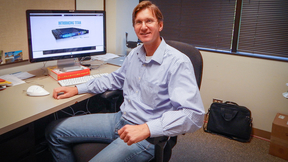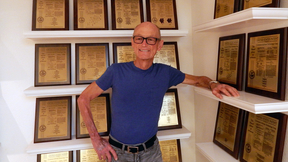Back
Contrary to popular belief, the fundamental security risks and privacy problems of Internet voting are too great to allow it to be used for public elections, and those problems will not be resolved any time soon, according to David Jefferson, who has studied the issue for more than 15 years.Jefferson, a computer scientist in the Lawrence Livermore’s Center for Applied…
Edgar Leon, a computer scientist in the Livermore Computing (LC) Division, has been elevated to the grade of Institute of Electrical and Electronics Engineers (IEEE) senior member.Only 7 percent of IEEE's approximately 431,000 members hold this prestigious status, which reflects professional maturity and requires extensive experience and documented achievements. "I’m…
LIVERMORE, California – With national and global threats related to cybercrime at an all-time high, there is a considerable and growing need for expertise in cybersecurity. The Department of Energy’s National Nuclear Security Administration (DOE/NNSA) recently announced that Lawrence Livermore National Laboratory (LLNL) will participate as a partner in a Cybersecurity…
The Laboratory effort to conserve energy and reduce costs by consolidating data centers at LLNL has received a Sustainability Award from the U.S. Department of Energy. The program, begun in 2011, using LLNL’s High Performance Computing Strategic Facility Plan as a guide, has so far shutdown 26 data centers, representing 26,000 square feet of space, resulting in annual…
In 2014, Lawrence Livermore National Laboratory (LLNL) built on a 62-year tradition of translating basic science into technologies that ensure national security, address pressing real world problems and expand the boundaries of fundamental science.The top stories of the year are a reflection of the Laboratory’s ability to apply its core national security competencies to a…
As part of the Department of Energy’s Innovative and Novel Computational Impact on Theory and Experiment (INCITE) program, eight Lawrence Livermore National Laboratory (LLNL) researchers have been awarded nearly 800 million core hours on two of America’s fastest supercomputers dedicated to open science – Mira, an IBM Blue Gene/Q system located at Argonne National…
The partnership that produced the first-of-a-kind Catalyst supercomputer was selected for an HPCWire "Best HPC Collaboration Between Government & Industry" award by readers and editors of the publication.HPCWire publisher Tom Tabor presented the award to representatives from the Laboratory, Intel and Cray in the DOE booth at the SC14 supercomputing conference in New…
New Orleans, Louisiana. Nov. 18, 2014 -- Lawrence Livermore National Laboratory scientists’ search for new ways to solve large complex national security problems led to the top ranking on Graph 500 and new techniques for solving large graph problems on small high performance computing (HPC) systems, all the way down to a single server. "To fulfill our missions in national…
Livermore, California -- Lawrence Livermore National Laboratory (LLNL) today announced a contract with IBM to deliver a next-generation supercomputer in 2017. The system, to be called Sierra, will serve the National Nuclear Security Administration’s (NNSA) Advanced Simulation and Computing (ASC) program.Procurement of Sierra is part of a U.S. Department of Energy (DOE)…
LIVERMORE, California - New medications created by pharmaceutical companies have helped millions of Americans alleviate pain and suffering from their medical conditions. However, the drug creation process often misses many side effects that kill at least 100,000 patients a year, according to the journal Nature. Lawrence Livermore National Laboratory researchers have…
Lawrence Livermore National Laboratory computational scientist Amanda Randles has received a Director's Early Independence Award from the National Institutes of Health (NIH).The NIH Common Fund award provides funding to encourage exceptional young scientists to pursue "high risk, high reward" independent research in biomedical and behavioral science. Randles will receive…
Lawrence Livermore National Laboratory signed a Strategic Partnership Agreement last week with the San Francisco Minority Business Development Agency (MBDA) Business Center that enables both sides to tap into resources to help develop minority-owned businesses.The SF Business Center is one of many across the nation operated by the MBDA, an agency within the Department of…
High performance computing (HPC) will be used to develop and apply the most complete climate and Earth system model to address the most challenging and demanding climate change issues. Eight national laboratories, including Lawrence Livermore, are combining forces with the National Center for Atmospheric Research, four academic institutions and one private-sector company…
A record 58 employees and students took part in Computation's summer hackathon, held from July 31 to Aug. 1 in theHigh-Performance Computing Innovation Center. The event was hosted byLivermore Computing. During hackathons, participants -- working individually or in teams -- strive to complete a Computation-related project of their choice in 24 hours or less. The measure of…
Lawrence Livermore's Celeste Matarazzo was attending a cybersecurity conference when she was struck with a realization: The field of cybersecurity had a diversity problem."It's about more than racial or gender diversity -- it's about diversity of thought. Both cybercrime and cybersecurity are only limited by imagination, and we as a nation can't be secure without a diverse…
Lawrence Livermore National Laboratory is joining Bechtel BNI and Los Alamos National Laboratory to train a new class of cyber defense professionals to protect the nation's critical digital infrastructure. The Bechtel-Lawrence Livermore-Los Alamos Cyber Career Development Program is designed to allow the national labs to recruit and rapidly develop cyber security…
A team of researchers led by Andreas Kemp has received a 2014 Leadership Computing Challenge award from the DOE Office of Advanced Scientific Computing Research (ASCR) to further pursue the study of short-pulse laser interactions with solid density plasmas using supercomputer simulations.The research project entitled "Laser-driven relativistic electron beam filamentation…
Editor's note: This article is part of an occasional series about LLNL entrepreneurs. John Hallquist knew it was a game changer when he invented a small computer code to analyze the structures of bombs dropped by U.S. Air Force jets. It was 1976 and Hallquist was a young engineer who had joined Lawrence Livermore National Laboratory after getting his Ph.D. from Michigan…
Catalyst, a first-of-a-kind supercomputer at Lawrence Livermore National Laboratory (LLNL), is available to industry collaborators to test big data technologies, architectures and applications.Developed by a partnership of Cray,Intel and Lawrence Livermore, this Cray CS300 high performance computing (HPC) cluster is available for collaborative projects with industry…
The Lab has joined forces with two other national labs to deliver next generation supercomputers able to perform up to 200 peak petaflops (quadrillions of floating point operations per second), about 10 times faster than today's most powerful high performance computing (HPC) systems. The Collaboration of Oak Ridge, Argonne and Livermore (CORAL) national labs will produce…


